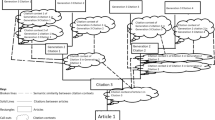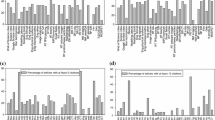Abstract
This study aims to examine whether rapid communications exert more influence/impact on subsequent research. Citation analysis of Short Communications (SCs) and Main Articles (MAs) from 1983 and 1990 for 5 high impact biomedical journals was carried out for a five year period following publication.
The mean citations cumulated for the five year period showed no consistent trend. Some journals showed more citations for SCs while some showed more for MAs. The mean citations (range) for SCs and MAs for the 1983 and 1990 papers respectively were as follows:Gene: 14.13 (0-61) and 38.79 (0-677), 9.73 (0-93) and 13.17 (0-44);Journal of Clinical Investigation (JCI): 79.77 (3-202) and 27.52 (0-86), 50.52 (0-254) and 33.53 (0-151);Journal of Experimental Medicine (JEM): 39.80 (0-200) and 49.20 (0-403), 47.26 (0-258) and 50.27 (0-173); andJournal of Biological Chemistry (JBC); 36.21 (0-380) and 19.67 (0-53), 37.19 (0-273) and 26.84 (0-185). SCs ofJournal of Cell Biology (JCB) had a mean citation of 25.84 per article with a range of 0-98, while the MAs had a mean citation of 33.13 with the range 4-122 during 1983-87.
The citation peak was seen about three years after publication for all the journals during both the periods. The mean cumulative citations showed a progressive increase over the five years for both types of papers, in all journals and for both the 5 year periods. The initial differences observed persisted even four years after the year of publication. No significant differences were observed in the distribution of the cumulative 5 year citations between the SCs and MAs. An index of speed of citation per article showed no substantial differences between SCs and MAs with MAs showing an edge over SCs. Both MAs and SCs of all the journals showed nearly same average time per citation per article further confirming that the SCs do not enjoy the advantage of speedier citation.
The results show that the generally perceived feeling of SCs getting cited more frequently and faster does not appear to be valid. Hence, the practice of publishing SCs on a priority basis is perhaps not warranted.
Similar content being viewed by others
References
R. M. Hazen, Hot from the laboratory,Nature, 335, 1988, 677–678.
L. Roberts, Rush to publish,Science, 251, 1991, 260–263.
A. Schubert, W. Glänzel, Mean response time: A new indicator of journal citation speed with application to physics journals.Czechoslovak Journal of Physics, B36, 1986, 121–125.
T. P. Stossel, Speed: An essay on biomedical communicatian,New England Journal of Medicine, 313, 1985, 123–126.
E. Garfield,Citation Indexing-Its application in science, technology and humanities, New York: John Wiley 1979.
K. Satyanarayana, K. V. Ratnakar, Authorship patterns in life sciences, preclinical basic and clinical research papers.Scientometrics, 17, 1989, 363–371.
K. Satyanarayana, S. R. Sastry, G. V. Satyavati,Adequacy of citations as indicators of research in the Third World-Nutrition research from India, Paper presented at the V. International Conference of Scientific Editors, Hamburg, June 14–19, 1987.
Author information
Authors and Affiliations
Rights and permissions
About this article
Cite this article
Satyanarayana, K., Srivastava, D. & Sreenivas, V. The relevance of short communication in scholarly journals: An empirical study. Scientometrics 44, 47–58 (1999). https://doi.org/10.1007/BF02458477
Received:
Issue Date:
DOI: https://doi.org/10.1007/BF02458477




